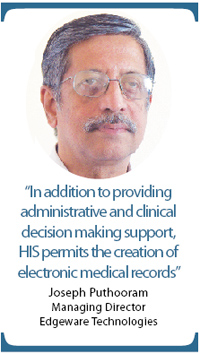Hospital information systems are an absolute necessity for managing information and data within hospitals
ByDivya Chawla

Healthcare, over the past decade, has witnessed the foray of information technology in different sectors. Albeit, with slow progress, numerous information systems have been developed and implemented in hospitals across the globe. This is evident in the increasing investments being made by hospitals towards information technology. And the scenario is no different in India. However, a strata of the healthcare society still believes that IT implementations in India still stands weak as compared to healthcare in the west. Sharing his views on this trend, Atul Bal, Director, Protech Systems said, “Information and management systems, when treated away from IT backbone, appear to be at primary stage (after crossing a stage of infancy), in India as compared to the similar medical setups in the west.”

 There is, however, a change in scenario. As put in by Sajal Kumar Agarwal, Managing Director, bbnisys Technologies, “With the rise in the per capita income of the Indian population, the demand for quality healthcare services including latest healthcare IT in the country has risen. This has compelled Indian hospitals and services providers to invest in the sector. Consequently, adoption of IT has become one of the top priorities for the Indian healthcare companies.” While, government hospitals are also now showing interest in IT solutions, the private sector remains the major driving force behind the growth of this market. Sajal Kumar Agarwal says, “India’s private healthcare sector, which currently contributes around 75 percent of the total healthcare expenditure, is expected to increase its spending on IT products specially hospital information systems (HIS) and hospital management information systems (HMIS) substantially in near future. However, initially the scope of the services will be limited to the Metro and Tier I cities only.”
There is, however, a change in scenario. As put in by Sajal Kumar Agarwal, Managing Director, bbnisys Technologies, “With the rise in the per capita income of the Indian population, the demand for quality healthcare services including latest healthcare IT in the country has risen. This has compelled Indian hospitals and services providers to invest in the sector. Consequently, adoption of IT has become one of the top priorities for the Indian healthcare companies.” While, government hospitals are also now showing interest in IT solutions, the private sector remains the major driving force behind the growth of this market. Sajal Kumar Agarwal says, “India’s private healthcare sector, which currently contributes around 75 percent of the total healthcare expenditure, is expected to increase its spending on IT products specially hospital information systems (HIS) and hospital management information systems (HMIS) substantially in near future. However, initially the scope of the services will be limited to the Metro and Tier I cities only.”

Need and objectives
 The ultimate objective of an HIS solution is to build a network of interdependent centres and departments. Departments such as the clinical laboratory, radiology, pharmacy, and so on can be interconnected, through an HIS, in order to effectively meet the needs arising within the hospital. This is extremely beneficial, as although these departments are individual centres, yet they are interdependent in terms of delivering services and to ensure effectiveness of providing care. An ideal HIS is expected to meet all information needs within a hospital. This includes data generated by various departments including patient information, billing, finance and accounting, staffing and scheduling, pharmacy ordering, prescription handling, supplies, inventory, maintenance and orders management, diagnostic reports related to laboratory, radiology and patient monitoring as well as providing decision support.
The ultimate objective of an HIS solution is to build a network of interdependent centres and departments. Departments such as the clinical laboratory, radiology, pharmacy, and so on can be interconnected, through an HIS, in order to effectively meet the needs arising within the hospital. This is extremely beneficial, as although these departments are individual centres, yet they are interdependent in terms of delivering services and to ensure effectiveness of providing care. An ideal HIS is expected to meet all information needs within a hospital. This includes data generated by various departments including patient information, billing, finance and accounting, staffing and scheduling, pharmacy ordering, prescription handling, supplies, inventory, maintenance and orders management, diagnostic reports related to laboratory, radiology and patient monitoring as well as providing decision support.
 The need for information availability and management, within a hospital set-up, arises because of various reasons. Up-to-date factual information is an absolute necessity when planning day-to-day tasks. The basic operational requirements can only be defined if there is availability of adequate information. Further, information is required for accurate planning, be it short-term or long-term. Patient-care and hospital management decisions are more or less based on the day-to-day trends, which can be analysed only if informationis present in an organised format. Another important factor is that documentation requirements such as maintenance of records, accreditation and legal records. Dr Ashish Dhawad, Founder and CEO, Medsynaptic, says “Any modern hospital in India today has to implement an HIS/HMIS to integrate and manage various departments like administration, finance and clinical.”
The need for information availability and management, within a hospital set-up, arises because of various reasons. Up-to-date factual information is an absolute necessity when planning day-to-day tasks. The basic operational requirements can only be defined if there is availability of adequate information. Further, information is required for accurate planning, be it short-term or long-term. Patient-care and hospital management decisions are more or less based on the day-to-day trends, which can be analysed only if informationis present in an organised format. Another important factor is that documentation requirements such as maintenance of records, accreditation and legal records. Dr Ashish Dhawad, Founder and CEO, Medsynaptic, says “Any modern hospital in India today has to implement an HIS/HMIS to integrate and manage various departments like administration, finance and clinical.”
Giving an outline of the need of an HIS, Jospeh Puthooram, Managing Director, Edgeware Technologies, says, “When one looks at the health of the nation preventive care needs to be a priority. While, a second perspective of healthcare relates to the micro local view of a patient, clinic or a hospital, as compared to macro national issues where the health of whole populations or nations are to be managed. In addressing both these perspectives through information technology, it is important to have clarity on the following concepts.” He adds, “When we look at the HIS or the HMIS, one is essentially looking at the local level of the hospital.” It is this perspective that needs to be changed to increase the adoption of HIS and HMIS at the level of government projects and health of the nation.
Market opportunities
 Healthcare is expected to be one of the key industries fuelling the software industry growth over the next five years. The healthcare industry has witnessed an increased spending on IT with most of the hospitals and healthcare organisations shifting to electronically-based information systems.
Healthcare is expected to be one of the key industries fuelling the software industry growth over the next five years. The healthcare industry has witnessed an increased spending on IT with most of the hospitals and healthcare organisations shifting to electronically-based information systems.
As per reports, although, the Asia-Pacific region witnessed numerous HIS implementations across various hospitals in Australia, Japan, South Korea, Singapore and Malaysia, yet, India and China have been lagging behind in terms of technology adoption. India undoubtedly is the hub of HIS software and development activity but Indian hospitals have been very late in realising the advantages of information technology. The future is however, expected to be bright with the industry gearing towards adopting IT in a big way.
Be a part of Elets Collaborative Initiatives. Join Us for Upcoming Events and explore business opportunities. Like us on Facebook , connect with us on LinkedIn and follow us on Twitter , Instagram.


